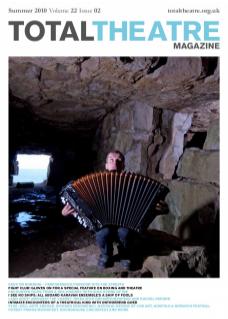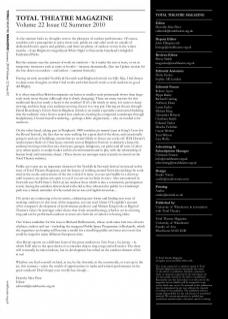As the summer kicks in, thoughts turn to the pleasures of outdoor performance. Of course, sunshine isn’t a prerequisite to enjoy street arts, public art and other work set outside of dedicated theatre spaces and galleries, and there are plenty of outdoor events in the winter months – from Brighton’s magnificent White Night to Newcastle-Gatehead’s delightful Enchanted Parks.
But the summer sees the amount of work set outdoors – be it under the sun or stars, or set in temporary structures such as tents or booths – increase dramatically. (See our Update section for the low-down on outdoor – and indoor – summer festivals.)
Having recently attended Norfolk & Norwich and Brighton festivals in chilly May, I feel drawn to share some thoughts on what I feel works and what doesn’t work so well outdoors in good old Blighty.
It is often stated that British companies are better at smaller-scale promenade shows than large-scale static street theatre (although that is slowly changing). There are many reasons for this traditional bias, but surely a factor is the weather? If it’s a bit windy or rainy, it is easier to keep moving, and thus keep your audience moving, than it is to stay put. Having sat frozen through David Rosenberg’s Electric Hotel in Brighton (which is set inside a specially-constructed building that the audience views from a seated area outdoors, hearing the composed soundscape through headphones), I found myself wondering – perhaps a little ungraciously – why we needed to be outdoors.
On the other hand, taking part in Periplum’s 1000 revolutions per moment (seen at King’s Cross for the Reveal festival), the fact that we were walking for a great deal of the show, and occasionally going in and out of buildings, meant that we weren’t likely to freeze our socks off. Willi Dorner’s outdoor piece Bodies in Urban Spaces, recently seen at Brighton Festival, is similarly a keep-the-audience moving event that uses doorways, garages, lampposts, car parks and all sorts of other (yes) urban spaces to sculpt bodies within an environment and to play with the relationship of human body and inanimate object. (These shows are amongst many recently reviewed on the Total Theatre website.)
Public art events are an important element of the Norfolk & Norwich festival (reviewed in this issue of Total Theatre Magazine), and the beauty of walking around Norwich catching the work sited in the nooks and crannies of the city is that if it rains, you can just huddle in a doorway until it passes, an option not open to you if you are sat in chairs in rows. Also encountered in Norwich was NoFit State’s Park Life (an outdoor show which is also a community participation event). Seeing the aerialists almost dead with cold as they rehearsed in public in a windswept park was a timely reminder of why tented circus was an English invention…
UK artists are continuing to be inventive, embracing new forms and finding new ways of working outdoors: in this issue of the magazine, you can read Alister O’Loughlin’s account of his company’s development of ‘performance parkour’; and Miriam King looks at Ragroof Theatre’s Gloves On (amongst other shows that circle around boxing), which is set in a boxing ring and can be performed outdoors at street arts festivals or indoors in boxing clubs.
Our Voices candidate for this issue is Richard DeDomenici, whose work takes him into all sorts of places, indoor and out – including the inaugural Public Space Programme in Reykjavík, which the organisers are hoping will become a model for a travelling public art/street arts event that could be staged in many different European cities.
Alex Byrne reports on a different form of the great outdoors in Tales From a Sea Journey – in which NIE take to the open decks of a container ship to sing songs and tell stories. The show will eventually be taken indoors, but its development has relied on the outdoor element of life at sea!
Whether you find yourself on land, at sea, by the riverside, in the countryside, or even up in the air, this summer – enjoy the wealth of opportunities to make and witness performance in the great outdoors! Don’t forget your woolly hat, though…

